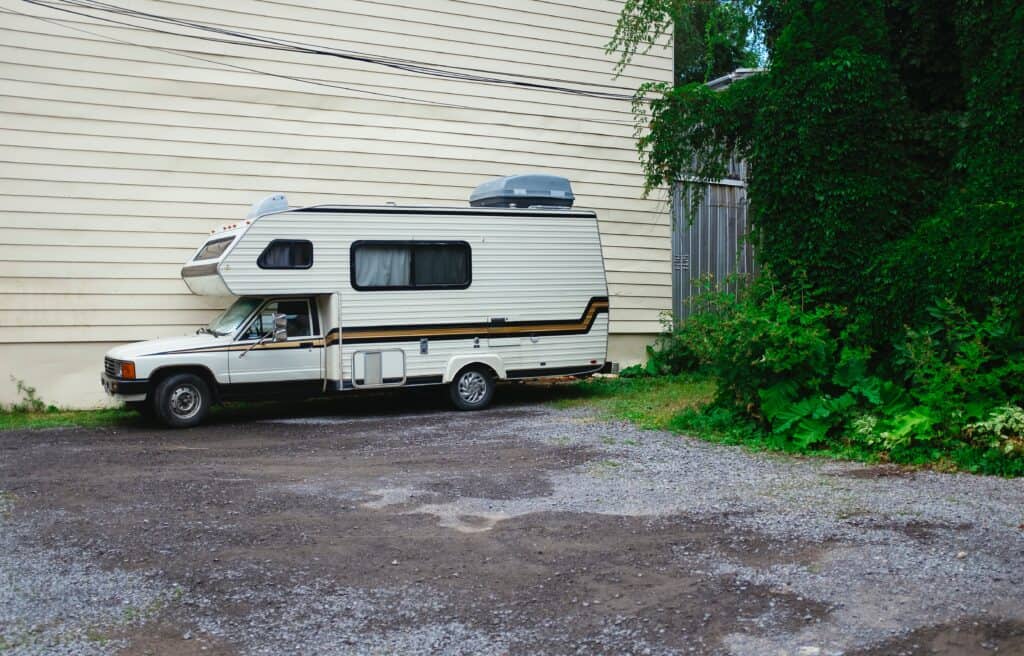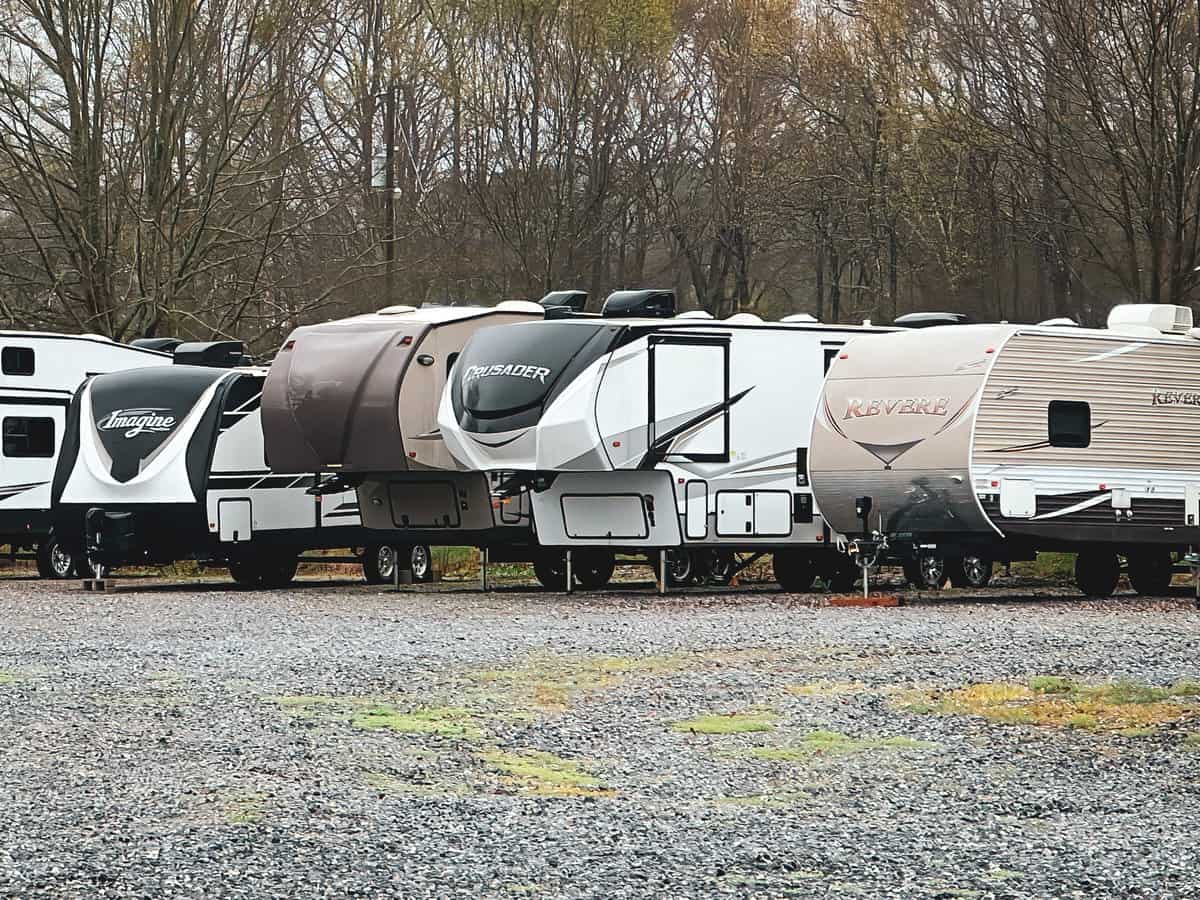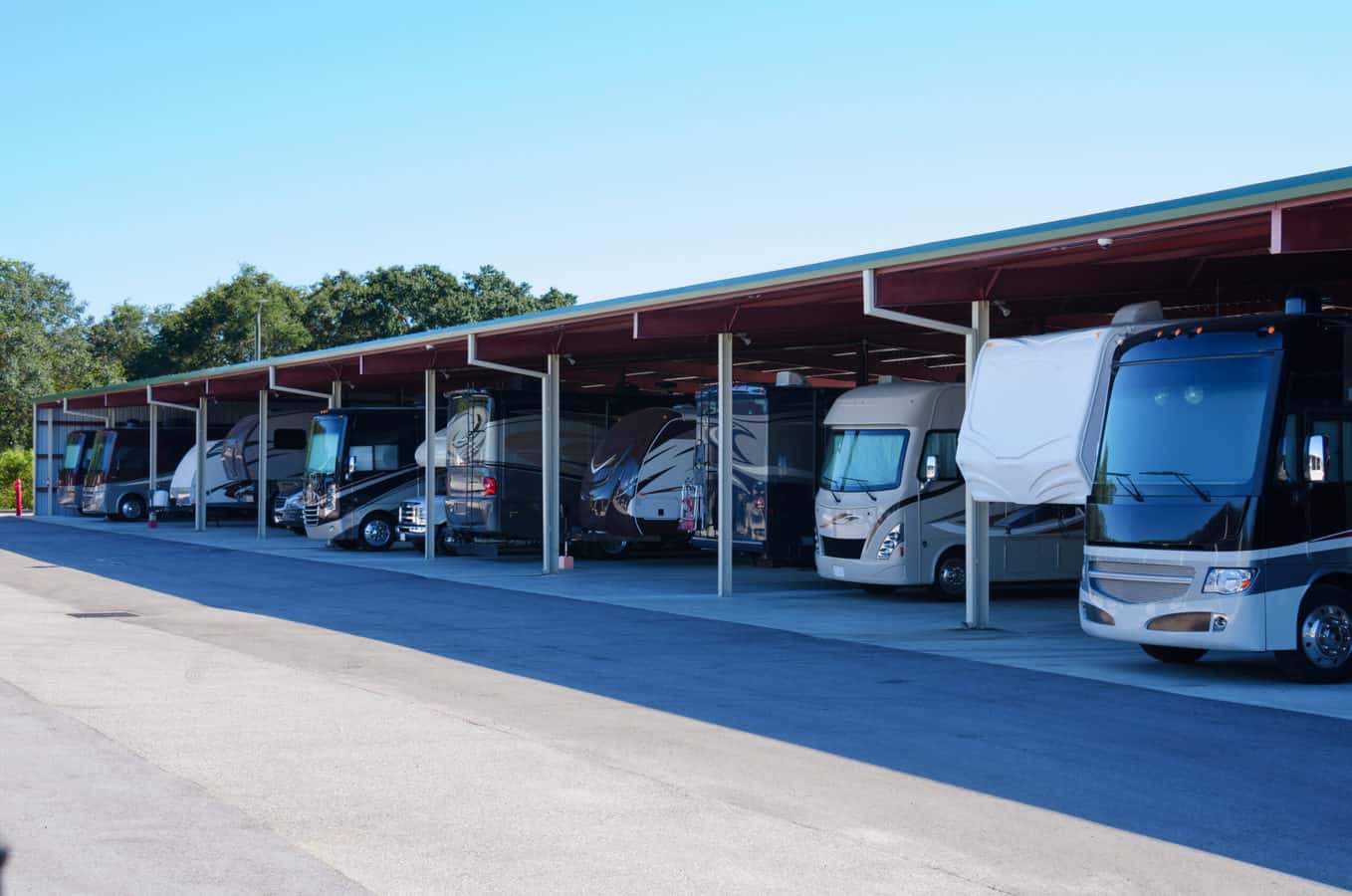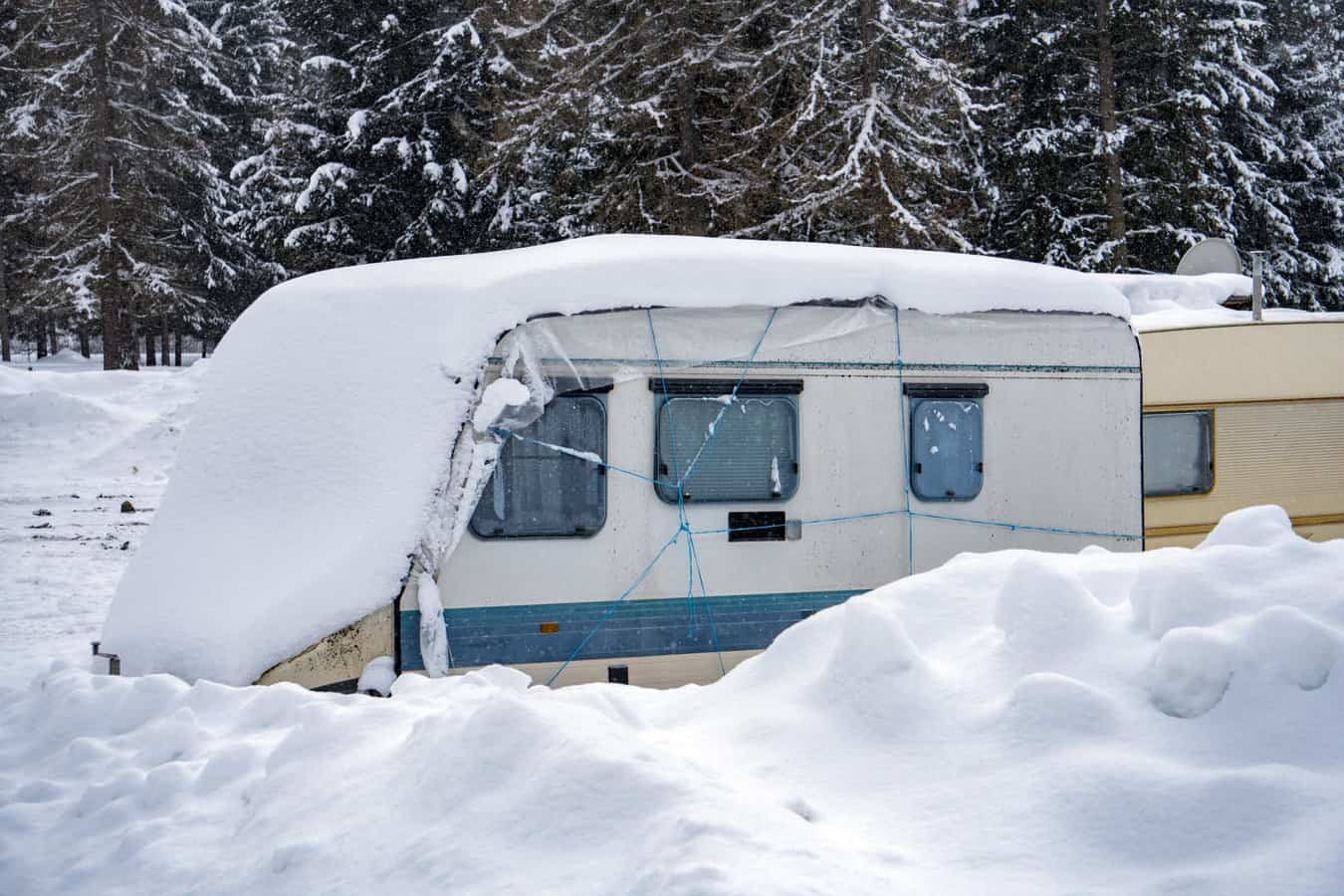The Complete Guide to Storing Your RV at Home
In the blink of an eye, this summer ends. Then, just as quickly, autumn disappears. What are you going to do with your RV at that point? Will you be storing your RV for the winter? Will you rent out your RV? A lucky few may live in climates that permit them to drive their RVs year-round. As for everyone else, we don’t get that luxury. Having a plan for where you’re going to stash your RV until sunny spring returns is crucial. Many RV owners elect to store theirs on a campground or storage facility. You might be interested in storing your RV at home over the winter.
Is this within your best interest? What do you need to do to prepare your home for your RV and vice-versa? Those are all great questions. In this guide, I plan on delving into every aspect of storing your RV at home, from space to maintenance and more.
Why Choose Storing Your RV at Home?
Vehicle storage facilities are made for fitting multitudes of RVs. Your home? Not so much. Why would you even want to keep this behemoth vehicle on your own property? There are a few reasons.
The first has to do with the almighty dollar. It’s the driving factor in making many decisions, including where you’ll be storing your RV for the off-season. If you put your vehicle in a park or facility, you’re going to pay for it. How much, exactly? According to Storage.com, if it’s an outdoor facility, you could have to cough up between $30 to $100+ monthly. The bigger your RV, the more you’ll end up shelling out. Remember, that’s for outdoor storage, not indoors.
If you do want to store your RV inside, this is going to be even costlier. An indoor storage facility that’s unheated may charge you anywhere between $50 and $125 per month. If you want a heated, indoor space, prepare to pay the big bucks, anywhere between $100 and $500.
Another important reason to consider storing your RV at home is the long-term care of the vehicle. Look, not every RV owner can afford to pay more than $100 a month to store their vehicle securely in an indoor, heated facility. What happens to that RV if it’s just left out?
It sits in the cold, exposed to the elements. If it snows or rains, your RV’s exterior takes the brunt of it. Sure, you can come out to the facility every few months and check on your baby, but that’s on the facility’s terms, not yours. When you are storing your RV is in your garage or driveway, you can clean it and tend to it as often as you wish.
Questions You Need to Ask Yourself before Storing Your RV at Home
You’ve read this far and you’re sold on the idea of keeping your RV at home during the off-season. Sadly, this is not an option for everybody. Before you make plans to cancel your storage at the local facility, you need to ask yourself the following questions.
1. Do I have the room to store my RV at home?
This is the biggest and most important question of all. Only you can answer this one, but there are some guidelines. If you have a Class A motorhome but your house is only a single story you may not have enough room to store your massive vehicle. If it’s a Class B or Class C, then that’s a somewhat more feasible setup.
Here are some numbers to chew on. Most Class C RVs are anywhere from 21 to 35 feet long, while many Class Bs are 16 to 22 feet. If your vehicle is approaching 40 feet or more, you’re out of luck.
2. Where can I store my RV on my property?
Next, you must decide where on your property your RV is going to sit. Most RV owners choose one of two spots: the driveway or the garage. If you have a bigger family with a few cars, no one else will be able to use the driveway for the winter besides you. Your RV will likely take up all available room. Even if it’s a Class B or C, these vehicles are sometimes bigger than they look.
You might elect then to park your RV in the garage for the winter. This is the more ideal option. That said, you must have the sufficient space and clearance for the setup to work. You’ll probably have to spend hours gutting the garage of everything in it. Your RV, especially if it’s a Class A or Class C, will hog up all available space inside.
3. Is it legal to store my RV at home?
Depending on the state you call home, it may not be legal to have your RV on your property. If you’re affiliated with a homeowner’s association, for instance, it’s rare this association would allow you to park your RV at home.
If your homeowner’s association by chance does permit this, you still have to check with your local municipality. My advice? Make the necessary phone calls before you park your vehicle for the off-season. Otherwise, you could be fined or ticketed. You may even risk having your RV towed.
4. Will my RV be in a safe, protected spot?
One of the reasons you’re storing your RV at home is to save money. The other one is to protect your vehicle long-term. If your RV is going to sit exposed to the elements in a driveway, then what’s the point? The protection it’d get here is no better than an what you’d find at an outdoor facility.
You want to make sure you can provide a safe spot for your vehicle. It should have some form of shelter. This doesn’t have to be a garage, per se, but it should be something.
5. Am I saving any money in the long run?
Let’s say you currently use your garage recreationally. This year, to save some moolah, you plan on storing your RV at home for the winter. To prepare for that, you decide to renovate your garage so it’s ready for your vehicle. Those costs add up quick. Soon, you might find yourself spending more money than you would have if you had taken your RV to a storage facility.
That’s just one example, of course. Little charges and related costs to keeping your RV at home can spring up left and right. Make sure these aren’t more than the cost of renting a spot at a storage facility.
6. Is it going to annoy my spouse/family/neighbors?
This is another big question to address. Your family probably loves spending springs and summers road-tripping in your RV, right? How will they feel when your vehicle is sitting there day in and day out all winter? Less than enthused or okay with it?
You also have to take your neighbors into consideration. If they deem your RV an eyesore, they could call the police. If you get reported enough times, your RV could again be towed away. Clear things with your neighbors before assuming you can keep your vehicle out all winter.
Parking Your RV: How and Where to Do It
Now it’s time to park your RV. You’ve already decided whether your driveway or garage is more suitable for storing your RV, based on the list of questions I provided above. Parking isn’t always as easy as a one-and-done job, though. For instance, what if your garage or driveway sit at an angle? It’s quite common for driveways to be sloped rather than straight. This can be problematic in several ways.
Weight Distribution
First, there’s the matter of weight distribution. If you are storing your RV at an angle, items can shift and weight can redistribute to one or two corners of the vehicle. This can put damage on the axles and other interior and exterior components. Not only that, but the RV refrigerator may suffer some damage, too. If you remember from my post about trailer and RV refrigerator troubleshooting, it’s crucial that you keep your fridge on an even keel. Otherwise, ammonia sediment is likely to develop. This occurs once the cooling unit and other components get liquid ammonia where it shouldn’t be. One major culprit for this issue is the angle in which the fridge sits. Too much ammonia sediment can prevent the fridge from running. That means your food goes bad much faster than it should.
Wheel blocks and trees
You’ll also have to use wheel blocks to keep your RV from rolling down your sloped driveway. It’s troublesome all the way, so try to avoid hills, angles, and slopes if you can. Also, when parking, you have to watch your home’s roofline. This is especially necessary if your garage is adjacent to the house or by the side yard. You could clip the roofline and cause major damage!
Trees can also give you headaches. That large spruce you meant to trim months ago has branches that are hard to push through to access your driveway or garage. Clean up trees and foliage before your RV settles in for the long haul.
Lastly, the following are some common-sense tips, but they’re worth mentioning. First, you must park in such a way that your neighbors can look beyond your RV. If it’s obstructing their view, they could be in danger when driving or walking down the street Second, don’t park anywhere near the sidewalk. Just don’t. You’ll probably end up in trouble for it.
Preparing Your Vehicle for the Winter
With your RV set in place for the long winter months ahead, there’s more still to be done. Winterizing your vehicle is mandatory so you’ll have an RV that’s ready to drive come the spring.
The following steps may not apply across all RVs, but most of them will. You might want to print this section of the article and use it as a checklist for your own vehicle.
Faucets, Drains, and Pumps
- Tend to your water pump. First, you want to pressurize it. Make sure the water pump is on when you begin this job. Access your faucets, going one at a time and flipping on both the cold and hot water valves. You should see antifreeze in the system at this point.
- Next, you’ll want to change out the water inlet screen and reduce pressure on the faucet and water pump. To do so, power down the water pump. Make sure the faucet is open. The pressure should begin moving out of the faucet through the city water inlet. Take the inlet screen off if it’s not already. You’ll probably need a screwdriver or other tiny tool to move the valve over the city water inlet screen. Once you’re done, change out the screen with a new one.
- Seal off every faucet across the RV. Yes, the bathroom and kitchen ones are obvious, but check your vehicle for any other faucets you may have missed.
- Go from one drain to the next, adding antifreeze. It’s recommended you dump in only a cup of the stuff per drain. This will keep all the drain pipes from freezing, even in colder temperatures.
- Now move to your black water and gray water holding tanks as well as the toilet. Here, you’ll want more antifreeze than just a cup. Try two or three cups; if that doesn’t suffice, then add more. Give the toilet a few flushes until antifreeze starts coming out in the water. That’s how you’ll know you’ve added enough.
- Consider getting a water heater bypass kit. Otherwise, antifreeze could flood the water heater. There may be more antifreeze than what you need, and it won’t move through your water lines as it should. That means you end up using antifreeze unnecessarily, sometimes up to six gallons of the stuff!
- You may have relied on your low point drain lines, of which there are two (one for cold water and the other for hot water) for emptying water. These drain lines, when run in conjunction with the water pump, allow water to move more quickly and efficiently. You should not keep these on once the water pump is turned off for the season, though.
Heaters and Seals
- Power down any electric heating elements that are included in your water heater. You don’t have to unplug them, per se, just make sure they’re not in use. You can take the electric heating element with you and keep it plugged in throughout the winter (outside of your vehicle) so it’s ready and working.
- Now you can empty the water heater completely. You should turn the heater off and let it sit for several hours before you begin. Touching it any sooner increases your risk of burns and other injuries. Once the water heater has cooled off, access the pressure relief valve through the drain plug and let all the water out that way.
- Look thoroughly at all seals inside and outside of the vehicle, especially those near windows and doors. You’re looking for any holes, cracks, or signs of damage. You may have to add new caulk if you spot any problem areas. Failing to do so invites insects, rats, and other unwanted critters to spend the winter in your RV.
- Make sure the roof vents are sealed.
Plumbing, Interior Items, and Electricity
- Inspect air conditioner plumbing vents for leaks and other signs of disrepair. Get these fixed before you leave your RV for the winter.
- Take out all removable furniture. Strip the beds of linens and don’t leave any clothes, blankets, hats, or other garments in the vehicle.
- Make sure you clear out every last cabinet, drawer, and shelf of food. Even if you have bottled, canned, or processed food that isn’t set to expire for months, don’t leave it behind. Critters will find it and stay aboard your vehicle. Wrappers and packaging can also tantalize. If you have a trashcan in your RV, empty it.
- Wipe down all the cabinets, the refrigerator and freezer, your stovetop, microwave, and oven. Any crumbs or food residue will also be like a magnet to critters.
- Unplug your refrigerator and freezer and let them dry out. Both should reach room temperature after a few hours. You might want to put some baking soda in the fridge for odors.
- You can and should take your propane tanks with you, keeping them full if you so prefer. You can place them in the garage or elsewhere, but it’s not recommended they sit in your RV all winter.
- Turn off the circuit breaker. If you’re on shore power, turn that off as well. Take out batteries from all external electrical devices, including alarm clocks, smoke and carbon monoxide detectors, radios, and clocks.
- Take gaming systems, TV, and other expensive electronics in the house with you.
- Unplug your battery and bring that with you as well.
Engine, Tires, and Exterior Parts
- Use fuel stabilizer on your engine to lessen the risk of excessive condensation. The engine of your RV should be on and idling when you do so. The warmth of the engine will dispel the stabilizer across its entirety.
- Add antifreeze to the windshield washer solution.
- Consider getting leveling jacks to boost the tires. This will prevent them from getting flat spots, leaving you an unpleasant surprise after the winter. Your RV will be slightly off the ground if you use leveling jacks, so you must make sure the vehicle is secure.
Considerations to Keep in Mind
The following considerations should all be weighed as you decide what to do with your RV in the off-season. I’m not sharing these with you to deter you from parking your vehicle at home. It’s just wise that you know all the facts before you make your decision about storing your RV at home. This way, you can do what’s best for your RV and your wallet.
Bugs/Insects/Critters
No place is safe from bugs and insects. This is doubly, sometimes triply true if your RV is sitting outside. If you choose an outdoor storage facility or your garage, then you need to be steadfast about insects. They can get in through any gap in your RV; the tiniest hole is all it takes.
That’s why it’s so important to seal everything off, as we covered earlier. Also, remember to clear your vehicle of all traces of food, including wrappers and other packaging. Otherwise, bugs and insects will smell food residue and come running.
You don’t only have to worry about insects. There’s also critters that go bump in the night that would love to make your RV their home. I’m talking about rats, mice, and sometimes even bats or raccoons. These animals are cold in the winter. Even though they’re covered in fur, they’ll seek any refuge they can find. Then they stumble upon your RV, which is moderately warm and protected from the weather. Of course they want to stay there!
Rats and mice can destroy your RV’s interior. They’ll chew up furniture and upholstery, shred wires with their teeth, wreck wood and other hard surfaces, and leave droppings and messes everywhere.
If you get bugs and critters in your house, then you could get them in your RV as well. Whether it’s in your garage or driveway, you need to check for insects and other pests regularly in the winter.
Security Measures
If your RV is just sitting there in your driveway, you have more than the elements to stress over. There’s also the unfortunate possibility that someone could vandalize, destroy, and even try to steal your vehicle.
“But,” you say, “I live in a good neighborhood. I don’t have to worry about vandalism or theft, do I?” You’d be surprised. An RV is a major investment. Even non-owners know that. To some people, your RV is a sitting duck that can be used to make them money.
For that reason, you might want to consider getting security installed in and around your RV. This can be costly, running you several hundred to several thousand dollars depending on the kind of tech you use. The necessity for security only applies if your vehicle is out in the open in your driveway. If you can fit it into your garage, it’s much harder to steal or vandalize. It’s not impossible, but it’s less likely to happen.
To Gate or Not to Gate
Speaking of security, you’re not without options if your RV won’t squeeze into your garage. You can always get your home gated, but this is no cheap venture. Doing so does decrease the chances of vandalism and theft, as most criminals would be deterred by a gated property. It’s not a totally foolproof safety measure, but it’s one worth thinking about.
Storing the Battery
I don’t want to sound like a broken record here, as I’ve mentioned RV batteries many, many a time. You should know by now then why it’s so necessary to properly care for your battery. Part of that responsibility means taking the battery out during the winter. If left to sit in your vehicle during the offseason, chances are high the battery will freeze. You’ll then come back to an RV with no electricity. That means a dead fridge, dead lights, dead everything, really.
That can still happen even if you take your RV battery out of the vehicle. How? It all depends on where you leave it for the offseason. If you just keep your battery any ol’ place, it could get overly cold or even hot. An overheated battery is just as useless as a frozen one, after all. Instead, it’s best if you stash your battery in a place with mild temperatures. It should be out of the sunlight and placed on plywood or another surface, not straight on the floor. Also, charge it when it gets to 80 percent, so semi-regularly.
Covering Your RV
If the driveway is the only place your RV will fit, certainly consider buying a cover for your vehicle. This will prevent most external damage from rain, wind, and snow. It will also prevent sun fading. You get better temperature control with a cover. The RV will maintain at least some warmth with this bonus insulation, even in the cold of winter.
RV covers are not insect-proof or critter-proof. Determined creatures like mice or rats can eat through your cover, especially if it’s fabric. By spraying critter repellant all over the cover, you should ward them off.
Another Option—Rent Out Your RV
One way to make the most use of your RV is to not store it at all. Rent it out. I know it might sound daunting but companies like Outdoorsy and RVShare makes the process really simple and will post your RV or Camper for rent in your local area so others can find it easily. It’s a lot like Airbnb but for Campers and RVs.
Conclusion
If you’re seriously considering storing your RV at home, there’s a lot of challenges and decisions that lie ahead. If you can do so legally and fit your vehicle in your garage, you’re in the best shape. You can still keep your RV in your driveway, but it’s more susceptible to weather-related damage.
While you can save money and perform more maintenance by parking your RV at home, it’s not all easy. You still have to winterize the vehicle. You also must consider if it’s worth gating gates and security equipment for safety and privacy. Hopefully, this guide will aide you as think ahead to the winter and what you’ll do with your RV.






You made a great point about knowing where you can keep your RV on your property and making sure that it can be easy to get to. My husband and I are looking for tips on how to store and protect our RV and we want to get a windshield cover in case of frost or storms. We will keep these tips in mind as we search for a professional that we can get one from. https://rvtoystore.com/product-category/windshield-covers/
Hi! I live in Florida where it’s always HOT & HUMID. Should I keep my air conditioner running year round while my travel trailer sits in my driveway when not in use? I wasn’t sure if it’s bad for it to be closed up in extreme heat.
I like that you suggested installing a security system around your RV to make sure that you’ll be able to protect your major investment. My husband is planning to buy an RV. He said that he’s interested in camping with the whole family so we can bond with each other. This is why he wants to have family trips and activities. He will surely do all your tips to keep his RV secured at all times.
Yes, I do agree that Another important reason to consider storing your RV at home is the long-term care of the vehicle. RV Liquid Roof is a safe choice for roof care.
I have a 2 question may be you can answer:
1. we live in Texas and we would like to use our rig in the winter. What should we do to minimize water freezing in the rig when temps drop belowing freezing.
2. Will the water freeze if the temps drop 31 or 30 for a couple of hours. I understand that they have to stay below freezing for at least 24 hrs. Is this correct?